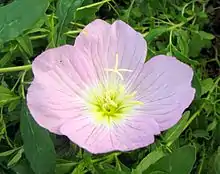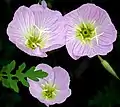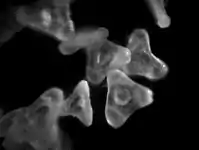Oenothera speciosa
Oenothera speciosa is a species in the evening primrose family known by several common names, including pinkladies, pink evening primrose, showy evening primrose, Mexican primrose, and buttercups (not to be confused with true buttercups in the genus Ranunculus).
| Oenothera speciosa | |
|---|---|
 | |
| Scientific classification | |
| Kingdom: | Plantae |
| Clade: | Tracheophytes |
| Clade: | Angiosperms |
| Clade: | Eudicots |
| Clade: | Rosids |
| Order: | Myrtales |
| Family: | Onagraceae |
| Genus: | Oenothera |
| Species: | O. speciosa |
| Binomial name | |
| Oenothera speciosa | |
| Synonyms[2] | |
| |
Description
Oenothera speciosa is a herbaceous perennial wildflower. It has glabrous (smooth) to pubescent stems that grow to 50 centimetres (20 inches) in height. The pubescent leaves are alternate with very short or no petiole (sessile), reaching 10 cm (4 in) long to 4 cm (1+1⁄2 in) broad. They are variable in shape, from linear to obovate, and are toothed or wavy-edged. It produces single, four-petaled, cup-shaped flowers on the upper leaf axils. These fragrant shell-pink flowers bloom throughout the summer into early autumn. The 4–5 cm (1+1⁄2–2 in) flowers start out white and turn pink as they age.
The flower throats, as well as the stigmas and stamens, have a soft yellow color. It blooms both day and night, but typically in the pre-dawn hours, closing when the full sun hits them. They bloom from March to July, and occasionally in the fall. The flowers are frequented by several insect species, but moths are the most common as the flowers are mostly open at night.
Taxonomy
The specific name, speciosa, means "showy".
This plant may be referred to as a buttercup, though it is not a true buttercup (genus Ranunculus), or even in the buttercup family.
Distribution and habitat
Originally native to the grasslands of Kansas, Missouri, Nebraska, northeastern New Mexico, Oklahoma, and Texas,[3] it has been naturalized in 28 of the lower 48 United States[4] as well as Chihuahua and Coahuila in Mexico. It frequently escapes from gardens.
The plant's wild habitat includes rocky prairies, open woodlands, slopes, roadsides, meadows and disturbed areas. While it makes an attractive garden plant, care should be taken with it as it can become invasive, spreading by runners and seeds. This drought-resistant plant prefers loose, fast-draining soil and full sun. It is a groundcover.
The pink evening primrose is used in the temperate latitudes as an ornamental plant, but does not survive severe winters. Within the United States Department of Agriculture's hardiness zone climates 4 to 9, and in most areas of Central Europe, the species should be sufficiently hardy. In Europe plant has been reported to cause deaths of eurasian hummingbird hawk-moth as they get stuck into the flower while foraging.[5]
Uses
The green plant parts can be cooked or eaten as a salad; the taste is pleasant when harvested before flowers develop.[6]
Gallery
 A field of O. speciosa
A field of O. speciosa Unopened flower buds
Unopened flower buds

 O. speciosa with bud and leaf
O. speciosa with bud and leaf Pollen magnified 200x
Pollen magnified 200x
References
- "Oenothera speciosa". Germplasm Resources Information Network. Agricultural Research Service, United States Department of Agriculture. Retrieved 28 October 2010.
- "Oenothera speciosa Nutt.". World Checklist of Selected Plant Families. Royal Botanic Gardens, Kew. Retrieved 7 December 2014 – via The Plant List. Note that this website has been superseded by World Flora Online
- "Lady Bird Johnson Wildflower Center - The University of Texas at Austin". www.wildflower.org. Retrieved 3 May 2019.
- USDA, NRCS (n.d.). "Oenothera speciosa". The PLANTS Database (plants.usda.gov). Greensboro, North Carolina: National Plant Data Team. Retrieved September 4, 2010.
- Zlatkov, Boyan; Beshkov, Stoyan; Ganeva, Tsveta (7 Dec 2017). "Oenothera speciosa versus Macroglossum stellatarum: killing beauty". Arthropod-Plant Interactions. Springer Science and Business Media LLC. 12 (3): 395–400. doi:10.1007/s11829-017-9588-3. ISSN 1872-8855.
- Jelitto / Schacht / Feßler (1985): The Outdoor Jewelry Shrubs. Ulmer, Stuttgart, ISBN 3-8001-6156-7.
Further reading
- Tveten, Gloria; Tveten, John (1993). Wildflowers of Houston & Southeast Texas. Austin: University of Texas Press. ISBN 978-0-292-78151-1.
- Tenaglia, Dan. "Oenothera speciosa page". Missouri Plants. Missouri Botanical Garden.
